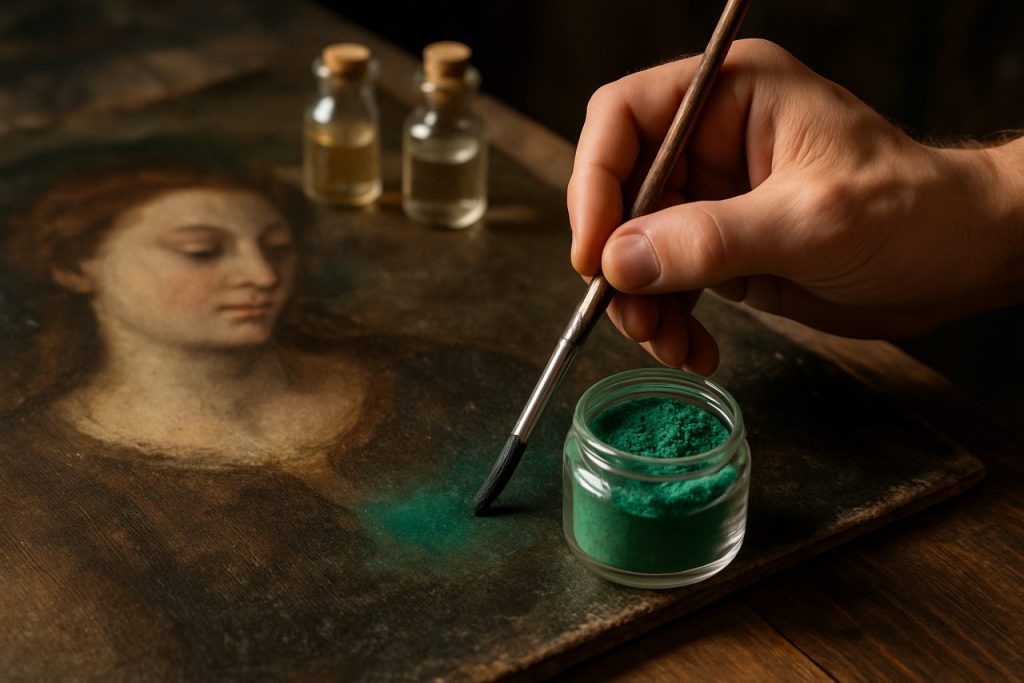
Unlocking the Power of Viridian: How This Vibrant Pigment Transforms Historical Art Restoration. Discover the Science, Challenges, and Triumphs Behind Its Use in Preserving Masterpieces.
- Introduction: The Legacy of Viridian in Art
- Chemical Composition and Properties of Viridian
- Historical Usage of Viridian Pigment in Masterpieces
- Degradation and Stability: Viridian’s Performance Over Time
- Analytical Techniques for Identifying Viridian in Artworks
- Case Studies: Viridian in Iconic Restoration Projects
- Challenges in Matching and Reproducing Historical Viridian
- Conservation Ethics: Authenticity vs. Intervention
- Innovations in Viridian Synthesis for Restoration
- Future Directions: Viridian’s Evolving Role in Art Conservation
- Sources & References
Introduction: The Legacy of Viridian in Art
Viridian, a vibrant green pigment composed primarily of hydrated chromium(III) oxide, has played a significant role in the evolution of modern art since its commercial introduction in the 19th century. Its unique hue, stability, and non-toxic nature distinguished it from earlier green pigments such as verdigris and emerald green, which were often chemically unstable or hazardous to artists’ health. The pigment’s name derives from the Latin word “viridis,” meaning green, reflecting its deep, bluish-green coloration that became highly prized among painters for its versatility and permanence.
The adoption of viridian coincided with a period of rapid innovation in pigment technology and artistic technique. Renowned artists such as Claude Monet and Paul Cézanne incorporated viridian into their palettes, exploiting its transparency and chromatic intensity to achieve new effects in landscape and portraiture. Its resistance to light and chemical degradation made it especially valuable for works intended to endure, and it soon became a staple in both oil and watercolor media. The pigment’s chemical stability also meant that it interacted predictably with other colors, allowing for more reliable mixing and glazing techniques.
In the context of historical art restoration, viridian’s legacy is twofold. First, its widespread use in 19th- and early 20th-century artworks means that conservators frequently encounter it when analyzing and treating paintings from this era. Second, its chemical resilience presents both opportunities and challenges: while viridian is less prone to fading or alteration than many contemporaneous pigments, it can still be affected by environmental factors or incompatible restoration materials. Accurate identification and understanding of viridian’s properties are therefore essential for developing appropriate conservation strategies.
Institutions such as the National Gallery in London and the Metropolitan Museum of Art in New York have conducted extensive research into the behavior of viridian in historical paintings, employing advanced analytical techniques to assess its condition and inform restoration practices. These efforts underscore the pigment’s enduring significance—not only as a material of artistic expression but also as a subject of scientific inquiry within the field of cultural heritage preservation. As restoration methodologies continue to evolve, the legacy of viridian remains integral to both the history and future of art conservation.
Chemical Composition and Properties of Viridian
Viridian, known chemically as hydrated chromium(III) oxide (Cr2O3·2H2O), is a synthetic green pigment that has played a significant role in historical art restoration due to its stability and unique chromatic properties. First introduced in the 19th century, viridian quickly became favored among artists and conservators for its vivid bluish-green hue, semi-transparency, and resistance to light and chemical degradation. The pigment’s chemical structure consists of chromium ions coordinated with oxygen and water molecules, which imparts both its characteristic color and its notable inertness.
One of the defining features of viridian is its exceptional permanence. Unlike many organic and some inorganic green pigments, viridian is highly resistant to fading when exposed to light, atmospheric pollutants, or moisture. This stability is attributed to the strong covalent bonds within the chromium oxide lattice, which prevent the pigment from undergoing significant chemical changes over time. As a result, viridian is often used in the restoration of historical artworks where long-term color retention is essential. Its low reactivity also means it does not interact adversely with other pigments or binding media, making it a safe choice for complex restoration projects.
The pigment’s particle size and morphology further contribute to its desirable properties. Viridian typically consists of fine, evenly distributed particles, which allow for smooth application and excellent dispersion in various media, including oil, tempera, and acrylic. This fine texture not only enhances the visual qualities of restored artworks but also ensures that the pigment integrates seamlessly with original paint layers, minimizing the risk of visible retouching.
From a conservation perspective, viridian’s chemical inertness is particularly valuable. It does not readily undergo oxidation or reduction reactions, nor does it catalyze the degradation of organic materials in the paint matrix. This makes it suitable for use in environments where other pigments might deteriorate or cause damage to adjacent materials. Furthermore, viridian is non-toxic compared to earlier green pigments such as verdigris or emerald green, which contained copper or arsenic compounds and posed health risks to artists and conservators.
The continued use of viridian in art restoration is supported by research and guidelines from leading conservation organizations, such as the British Museum and the J. Paul Getty Trust, both of which emphasize the importance of pigment stability and compatibility in the preservation of cultural heritage. These properties make viridian an indispensable material in the toolkit of modern art conservators.
Historical Usage of Viridian Pigment in Masterpieces
Viridian, a hydrated chromium(III) oxide pigment, has played a significant role in the palette of artists since its commercial introduction in the 19th century. Its distinctive bluish-green hue, chemical stability, and relative non-toxicity made it a favored choice among painters seeking alternatives to earlier, less stable green pigments such as verdigris and malachite. The pigment’s adoption coincided with a period of rapid innovation in artists’ materials, and its presence can be traced in the works of numerous influential painters, including Claude Monet, Paul Cézanne, and Vincent van Gogh.
The historical usage of viridian is well documented in masterpieces from the late 1800s onward. For instance, Monet’s series of water lilies and landscapes often feature viridian to achieve vibrant, lasting greens that resist fading and discoloration. Cézanne’s landscapes and still lifes also reveal the pigment’s characteristic cool green tones, which contributed to the subtle modulation of color and light in his compositions. Van Gogh, known for his expressive use of color, incorporated viridian in his later works, exploiting its intensity and transparency to create dynamic contrasts and depth.
The pigment’s chemical composition—Cr2O3·2H2O—confers exceptional lightfastness and resistance to chemical change, qualities that have made viridian a reliable component in artists’ paints and, subsequently, in art restoration. Its stability under normal environmental conditions means that viridian passages in historical paintings often retain their original vibrancy, providing conservators with valuable reference points during restoration. This is particularly important when reconstructing or retouching areas where original paint has been lost or damaged, as the enduring color of viridian can guide accurate color matching and material selection.
Institutions such as the National Gallery in London and the Metropolitan Museum of Art in New York have conducted technical studies on paintings containing viridian, using analytical techniques like X-ray fluorescence (XRF) and Raman spectroscopy to identify and map the pigment’s distribution. These investigations not only confirm the widespread historical use of viridian but also inform best practices in conservation, ensuring that restoration efforts respect the original materials and artistic intent.
In summary, viridian’s historical usage in masterpieces underscores its importance in both the creation and preservation of cultural heritage. Its enduring presence in iconic works continues to shape the methodologies and ethical considerations of art restoration today.
Degradation and Stability: Viridian’s Performance Over Time
Viridian, a hydrated chromium(III) oxide pigment, has been widely used in historical artworks since its introduction in the 19th century. Its distinctive bluish-green hue and relative chemical stability made it a favored choice among artists and manufacturers. However, the long-term performance of viridian in artworks is a subject of ongoing research, particularly in the context of art restoration, where understanding pigment degradation is crucial for conservation strategies.
Viridian is generally considered to be a stable pigment under normal environmental conditions. Its resistance to light, heat, and chemical agents surpasses many earlier green pigments, such as verdigris and copper-based greens, which are prone to discoloration and chemical alteration. The pigment’s stability is largely attributed to the inertness of chromium(III) oxide, which does not readily react with atmospheric pollutants or binders commonly used in oil and watercolor paints. This has been confirmed by analytical studies conducted by conservation science laboratories, including those associated with major museums and research institutions such as the British Museum and the J. Paul Getty Trust.
Despite its reputation for stability, viridian is not entirely immune to degradation. Some studies have reported that under certain conditions—such as prolonged exposure to acidic environments, high humidity, or incompatible binding media—viridian can undergo subtle changes. These may include a loss of gloss, slight color shifts, or the formation of surface crusts. In rare cases, interactions with sulfur-containing compounds or pollutants can lead to the formation of chromium sulfates, which may alter the pigment’s appearance. Such phenomena are of particular concern in the restoration of works that have been exposed to urban pollution or stored in less-than-ideal conditions.
Restorers and conservation scientists employ a range of analytical techniques, including X-ray diffraction (XRD), Fourier-transform infrared spectroscopy (FTIR), and scanning electron microscopy (SEM), to assess the condition of viridian in historical paintings. These methods help identify degradation products and inform decisions about cleaning, consolidation, and retouching. Guidelines and best practices for handling viridian-containing artworks are often developed in collaboration with organizations such as the International Institute for Conservation of Historic and Artistic Works, which provides resources and forums for sharing research on pigment stability and conservation treatments.
In summary, while viridian is among the more stable historical pigments, its long-term performance is influenced by environmental and material factors. Ongoing research and collaboration among conservation professionals are essential to ensure the preservation of artworks containing viridian for future generations.
Analytical Techniques for Identifying Viridian in Artworks
The accurate identification of viridian pigment—chemically known as hydrated chromium(III) oxide—in historical artworks is crucial for informed conservation and restoration practices. Viridian, prized for its vivid green hue and stability, has been widely used since the 19th century. However, its visual similarity to other green pigments and potential for alteration over time necessitate the use of advanced analytical techniques to confirm its presence and assess its condition.
One of the primary methods employed is X-ray fluorescence (XRF) spectroscopy. This non-destructive technique enables conservators to detect the elemental composition of paint layers, specifically identifying chromium, the key element in viridian. XRF is valued for its portability and ability to analyze artworks in situ, minimizing risk to the object. Institutions such as the British Museum and the Metropolitan Museum of Art routinely utilize XRF in pigment analysis.
Another essential tool is Raman spectroscopy, which provides molecular-level information. Raman spectra of viridian display characteristic peaks corresponding to chromium-oxygen bonds, allowing for differentiation from other chromium-based greens like chrome oxide green. Raman analysis is particularly useful for distinguishing viridian from visually similar pigments and for detecting degradation products. The J. Paul Getty Trust, through its conservation institute, has contributed to the development and application of Raman techniques in art analysis.
Fourier-transform infrared (FTIR) spectroscopy is also widely used to identify viridian. FTIR detects vibrational modes of chemical bonds, providing a fingerprint for the pigment. This method is effective for identifying viridian even when it is mixed with binders or other pigments, as often found in historical paint layers.
In some cases, scanning electron microscopy with energy-dispersive X-ray spectroscopy (SEM-EDS) is employed. SEM-EDS offers high-resolution imaging and elemental analysis, enabling the study of pigment particle morphology and distribution within paint cross-sections. This is particularly valuable for understanding the manufacturing techniques and degradation processes affecting viridian.
The integration of these analytical techniques allows conservators to accurately identify viridian, assess its state of preservation, and make informed decisions regarding restoration. The use of non-invasive and micro-invasive methods ensures the protection of cultural heritage while advancing scientific understanding. Leading museums and conservation laboratories, including those affiliated with the Musée du Louvre, continue to refine these approaches, underscoring the importance of scientific analysis in art restoration.
Case Studies: Viridian in Iconic Restoration Projects
Viridian, a synthetic green pigment composed primarily of hydrated chromium(III) oxide, has played a significant role in the restoration of historical artworks since its introduction in the 19th century. Its stability, lightfastness, and compatibility with traditional painting media have made it a preferred choice for conservators seeking to match the original hues of masterpieces while ensuring the longevity of their interventions. Several high-profile restoration projects have highlighted the importance of viridian in both aesthetic and technical aspects of art conservation.
One notable example is the restoration of Claude Monet’s water lily series, where viridian was instrumental in recreating the vibrant, cool greens characteristic of the artist’s palette. The pigment’s unique chromatic properties allowed conservators to achieve seamless transitions between original and restored areas, preserving the visual integrity of Monet’s impressionistic brushwork. Institutions such as the Musée du Louvre and the National Gallery have documented the use of viridian in their conservation laboratories, emphasizing its role in maintaining the authenticity of 19th- and early 20th-century paintings.
In the restoration of Vincent van Gogh’s “The Bedroom,” viridian was carefully selected to match the original green tones that had faded or altered due to previous conservation treatments and environmental exposure. Analytical studies conducted by the Rijksmuseum and the Van Gogh Museum confirmed the presence of viridian in the artist’s original palette, guiding conservators in their choice of materials for inpainting and retouching. The pigment’s chemical stability ensured that the restored areas would remain visually consistent with the original over time, minimizing the risk of future discoloration.
Viridian has also been employed in the conservation of mural paintings and decorative arts, where its resistance to environmental factors such as humidity and light exposure is particularly valuable. The J. Paul Getty Trust, a leading authority in art conservation, has published technical guidelines on the use of viridian in restoration, highlighting its minimal reactivity and compatibility with both oil and tempera media.
These case studies underscore the enduring relevance of viridian pigment in the field of historical art restoration. By enabling precise color matching and offering long-term stability, viridian continues to support the preservation of cultural heritage in some of the world’s most iconic artworks.
Challenges in Matching and Reproducing Historical Viridian
The process of matching and reproducing historical Viridian pigment presents significant challenges for art conservators and restorers. Viridian, chemically known as hydrated chromium(III) oxide, was first introduced in the 19th century and quickly became prized for its brilliant, cool green hue and relative stability compared to earlier green pigments. However, the precise appearance of Viridian in historical artworks is influenced by a complex interplay of factors, making accurate reproduction a nuanced task.
One major challenge lies in the variability of historical manufacturing processes. Early Viridian was produced using different methods and raw materials, resulting in subtle differences in hue, particle size, and transparency. These variations are often undocumented, complicating efforts to identify the exact formulation used in a specific artwork. Modern Viridian pigments, while chemically similar, may differ in physical properties due to advances in purification and milling techniques, potentially leading to mismatches in color and texture when used in restoration.
Aging and environmental factors further complicate the matching process. Over time, Viridian can undergo changes due to exposure to light, humidity, and atmospheric pollutants. While Viridian is generally considered stable, it can sometimes darken or shift in tone, especially when mixed with certain binders or other pigments. This means that the original appearance of the pigment may differ significantly from its current state, requiring conservators to make informed judgments about the artist’s intent and the pigment’s original color.
Analytical techniques such as X-ray fluorescence (XRF), Raman spectroscopy, and scanning electron microscopy (SEM) are often employed to characterize the composition and morphology of historical Viridian samples. These methods, used by leading conservation institutions such as the J. Paul Getty Trust and the Metropolitan Museum of Art, help conservators understand the pigment’s current state and guide the selection of appropriate modern materials. However, even with advanced analysis, perfect color matching remains elusive due to the inherent variability in both historical and contemporary pigments.
Ethical considerations also play a role. Many organizations, including the International Institute for Conservation of Historic and Artistic Works, emphasize the importance of reversibility and minimal intervention in restoration. This means that any attempt to reproduce Viridian must balance visual integration with the original work and the need to preserve the artwork’s authenticity and historical integrity.
In summary, matching and reproducing historical Viridian pigment is a complex endeavor, requiring a combination of scientific analysis, historical research, and ethical decision-making to achieve results that honor both the artist’s vision and the artwork’s legacy.
Conservation Ethics: Authenticity vs. Intervention
The conservation of artworks containing viridian pigment—a synthetic green pigment introduced in the 19th century—raises complex ethical questions regarding authenticity and intervention. Viridian, chemically known as hydrated chromium(III) oxide, became popular among artists for its vivid hue and stability. However, like many historical pigments, it is susceptible to certain forms of degradation, such as darkening or alteration due to environmental factors. When conservators encounter viridian in need of restoration, they must carefully balance the imperative to preserve the artist’s original intent with the responsibility to maintain the artwork’s historical integrity.
A central ethical dilemma in art conservation is the tension between authenticity and intervention. Authenticity demands that the original materials and techniques of the artist be preserved as much as possible. This principle is championed by organizations such as the International Council of Museums (ICOM) and the J. Paul Getty Trust, both of which advocate for minimal intervention and the reversibility of any treatments applied. In the context of viridian, this means that any cleaning, consolidation, or retouching must not obscure or replace the original pigment unless absolutely necessary for the artwork’s survival.
On the other hand, intervention may be justified when the stability of the viridian pigment is compromised, threatening the legibility or structural integrity of the artwork. The International Institute for Conservation of Historic and Artistic Works (IIC) emphasizes the importance of documentation and transparency in such cases, ensuring that any additions or alterations are clearly distinguishable from the original. This approach allows future conservators to understand and, if needed, reverse previous interventions.
The use of modern analytical techniques, such as X-ray fluorescence (XRF) and Raman spectroscopy, enables conservators to identify the presence and condition of viridian without invasive sampling. These methods, supported by research from institutions like the British Museum, inform ethical decision-making by providing detailed information about the pigment’s composition and degradation state. Such data help conservators determine whether intervention is necessary and, if so, how to proceed in a manner that respects both the artwork’s authenticity and its long-term preservation.
Ultimately, the ethical restoration of viridian-containing artworks requires a nuanced approach, guided by international standards and a commitment to both authenticity and responsible intervention. By adhering to these principles, conservators strive to honor the original vision of the artist while safeguarding cultural heritage for future generations.
Innovations in Viridian Synthesis for Restoration
Viridian, a hydrated chromium(III) oxide pigment, has been prized in historical art for its vibrant blue-green hue, stability, and relative non-toxicity compared to earlier green pigments. In art restoration, the accurate recreation and application of viridian are crucial for maintaining the authenticity and longevity of restored works. Recent innovations in viridian synthesis have focused on improving pigment purity, particle size control, and environmental sustainability, all of which are vital for conservation professionals.
Traditional viridian production involved high-temperature calcination of chromium salts, often resulting in variable particle sizes and impurities that could affect color consistency and long-term stability. Modern synthesis methods, such as hydrothermal and sol-gel processes, allow for more precise control over these parameters. These techniques yield viridian pigments with uniform particle morphology and enhanced chromatic properties, which are essential for matching the original appearance of historical artworks. Such advancements also reduce the risk of unwanted chemical interactions with original paint layers during restoration.
Another significant innovation is the development of eco-friendly synthesis routes. Conventional viridian production can generate hazardous chromium(VI) byproducts, raising environmental and health concerns. Contemporary research has led to the adoption of closed-loop systems and alternative precursors that minimize or eliminate toxic waste, aligning with the conservation field’s growing emphasis on sustainability. These greener methods are increasingly being adopted by pigment manufacturers and restoration laboratories, ensuring safer working conditions and reduced ecological impact.
Analytical techniques such as X-ray diffraction (XRD), scanning electron microscopy (SEM), and Fourier-transform infrared spectroscopy (FTIR) are now routinely employed to characterize synthesized viridian. These tools enable restorers to verify pigment composition and structure, ensuring compatibility with historical materials. Institutions like the National Institute of Standards and Technology (NIST) and the British Museum have contributed to the development and dissemination of standardized analytical protocols, facilitating consistent quality in restoration projects.
Furthermore, collaborations between conservation scientists, pigment manufacturers, and cultural heritage organizations have accelerated the translation of laboratory innovations into practical restoration materials. The J. Paul Getty Trust, through its conservation institute, has played a pivotal role in researching and promoting advanced viridian synthesis methods tailored for art restoration. These efforts ensure that restorers have access to pigments that not only replicate historical aesthetics but also meet modern standards of safety and durability.
Future Directions: Viridian’s Evolving Role in Art Conservation
Viridian, a synthetic green pigment composed primarily of hydrated chromium(III) oxide, has played a significant role in historical art restoration since its introduction in the 19th century. As conservation science advances, the future of viridian in art restoration is shaped by both its material properties and the evolving priorities of the conservation community. One of viridian’s enduring advantages is its chemical stability and resistance to light-induced fading, making it a reliable choice for restoring original color palettes in historical paintings. Its non-toxic nature, compared to earlier green pigments like verdigris and emerald green, further supports its continued use in sensitive restoration projects.
Looking ahead, the role of viridian is likely to evolve in response to new analytical techniques and ethical considerations in conservation. The increasing use of non-invasive imaging and spectroscopic methods allows conservators to identify and map original viridian layers with greater precision, minimizing unnecessary intervention and preserving the authenticity of artworks. These technologies, supported by research institutions and museums worldwide, enable more informed decisions about when and how to use viridian in retouching or inpainting processes.
Sustainability and environmental impact are also influencing the future of pigment selection in conservation. While viridian is less hazardous than many historical pigments, ongoing research aims to further reduce the ecological footprint of pigment production and application. Organizations such as the J. Paul Getty Trust and the International Institute for Conservation of Historic and Artistic Works are at the forefront of promoting sustainable practices and materials in art conservation, including the responsible use of synthetic pigments like viridian.
Moreover, the integration of viridian with modern conservation materials—such as stable synthetic binders and reversible varnishes—enhances its compatibility with contemporary restoration standards. This synergy ensures that interventions remain distinguishable and reversible, aligning with the ethical guidelines established by leading conservation bodies. As the field continues to prioritize minimal intervention and reversibility, viridian’s predictable behavior and compatibility with a range of media will likely secure its place in the conservator’s palette.
In summary, the future of viridian in art conservation is characterized by a balance between tradition and innovation. Its proven stability, safety, and adaptability position it as a valuable tool for conservators, while ongoing research and ethical discourse will shape its application in the restoration of cultural heritage for generations to come.
Sources & References
- National Gallery
- Metropolitan Museum of Art
- J. Paul Getty Trust
- Musée du Louvre
- Rijksmuseum
- Van Gogh Museum
- International Council of Museums (ICOM)
- National Institute of Standards and Technology



